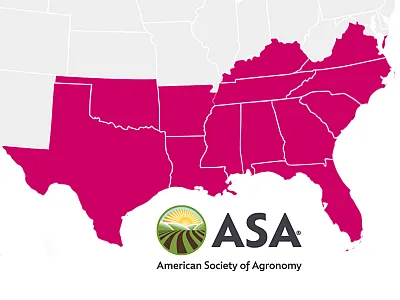Survey of weed management needs in Oregon mint production
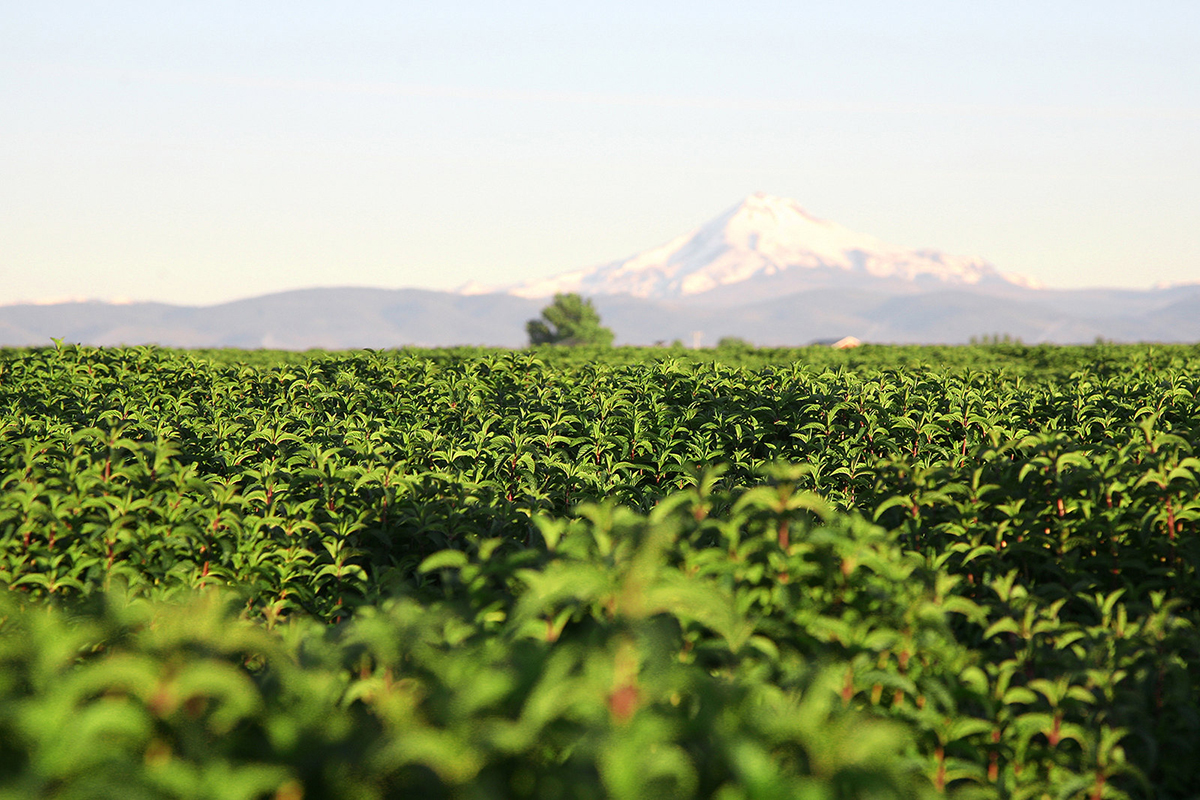
Oregon is one of the leading U.S. states for peppermint and spearmint production, accounting for 30 and 22% of the nation’s output, respectively. In 2024, more than 8,000 ac of peppermint and spearmint were harvested across Oregon, yielding over 1.6 million lb of oil. Weeds represent a major challenge to mint production, reducing both crop biomass and oil quality. Understanding current weed management challenges, as well as the resource and information needs of stakeholders, is critical for guiding research, extension, and education efforts for effective weed management. To support this effort, a statewide weed management needs assessment survey was conducted in 2025 to identify key challenges and priorities among Oregon’s mint stakeholders.
Oregon is one of the leading U.S. states for peppermint (Mentha × piperita L.) and spearmint (Mentha spicata L.) production, accounting for 30 and 22% of the nation’s output, respectively (ODA, 2024). In 2024, more than 8,000 ac of peppermint and spearmint were harvested across Oregon, yielding over 1.6 million lb of oil (Oregon Mint Assessment Report, 2025). Weeds represent a major challenge to mint production, reducing both crop biomass and oil quality. Understanding current weed management challenges, as well as the resource and information needs of stakeholders, is critical for guiding research, extension, and education efforts for effective weed management. To support this effort, a statewide weed management needs assessment survey was conducted in 2025 to identify key challenges and priorities among Oregon’s mint stakeholders.
Needs assessment survey
The survey was made available online through the Qualtrics platform from December 2024 to April 2025. A survey link was distributed via email to the Oregon Mint Commission. Additionally, it was shared on LinkedIn and Twitter, and a QR code linking to the survey was shared during the Oregon Mint Growers Meeting. Extension agents and crop consultants also assisted in distributing the survey.
The survey consisted of 25 questions organized into four sections: Section 1: general information; Section 2: weed management challenges; Section 3: current weed management practices; and Section 4: weed management research and extension priorities.
Survey responses
Section 1: General information
The survey had 32 respondents, most of whom were growers (47%) or crop consultants (34%) (Table 1). The majority reported farming or consulting in Benton, Linn, Marion, and Jefferson counties (Figure 1). Sixty-three percent of respondents grow peppermint while 38% grow both peppermint and spearmint. When asked about their experience growing mint, the largest proportion of respondents (39%) reported more than 20 years of experience. Over 70% of respondents farm or consult between 100 and 500 ac (Table 1).
| Q1. What is your role? (n = 32) | Respondents, % |
Grower | 47 |
Crop consultant | 34 |
Extension agent | 6 |
Researcher | 13 |
| Q2. Which county(ies) do you farm/consult/work? (n = 30) | |
| Refer to Figure 1 | |
| Q3. What type(s) of mint do you grow? (n = 32) | Respondents, % |
Peppermint | 63 |
Spearmint | 0 |
Both | 38 |
| Q4. How long have you been growing mint? (n = 31) | Respondents, % |
1–5 years | 26 |
5–10 years | 19 |
10–20 years | 16 |
> 20 years | 39 |
| Q5. How many acres of mint do you farm/consult/work? (n = 32) | |
< 10 acres | 13 |
10–50 acres | 3 |
50–100 acres | 13 |
100–250 acres | 22 |
250–500 acres | 28 |
> 500 acres | 22 |
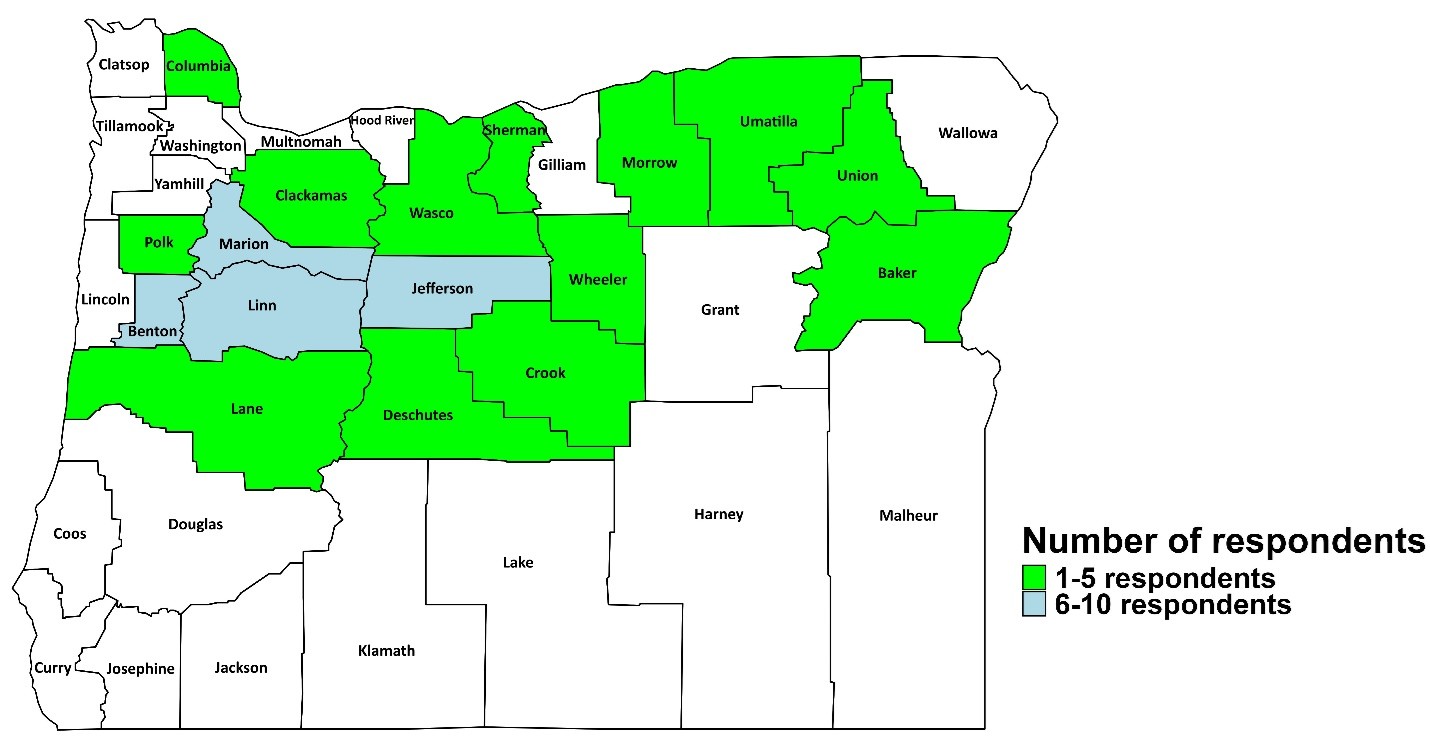
Section 2: Weed management challenges
Respondents reported difficulty controlling several weed species using multiple herbicides. Among the grass species, annual ryegrass, barnyardgrass, Italian ryegrass, and reed canary grass were listed as the most difficult to control; each was associated with at least three different herbicides. For broadleaf weeds, common groundsel was the most frequently reported with poor control associated with seven distinct herbicides. Other broadleaf weeds reported as difficult to control included Canada thistle, prickly lettuce, pigweeds, and wild mustard; each was associated with at least three different herbicides (Table 2).
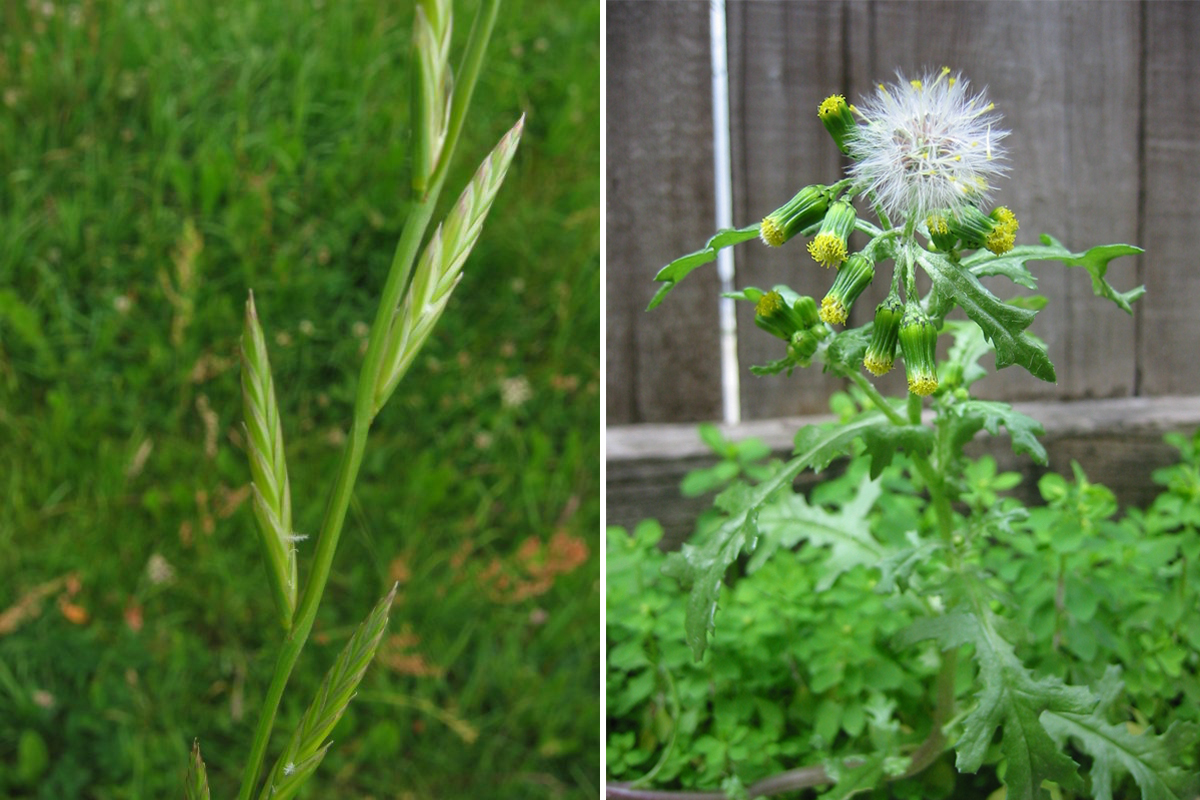
According to respondents, weeds pose the greatest challenge during the crop’s active growth stage with 54% identifying this period as the most problematic. In terms of specific weed management challenges, herbicide resistance was reported by 67% of respondents, followed by limited herbicide options (63%) and herbicide application timing (58%) (Table 2).
To better understand the economic impact of weed management in mint production, respondents were asked about their average weed control costs per acre. Thirty percent reported spending between $100 and $150 per acre, 26% indicated costs of $150 to $200 per acre, and another 26% reported spending more than $200 per acre. Additionally, 13% spent between $50 and $100 per acre while 4% indicated costs ranging from $10 to $50 per acre (Table 2).
Respondents were also asked a series of questions related to herbicide resistance, including their level of concern, experiences with herbicide failure or reduced efficacy, observations of resistant weeds, and the management strategies they implemented to address herbicide resistance. A majority (63%) reported being very concerned about herbicide resistance, 33% were somewhat concerned, and only 4% expressed no concern. When asked about their experiences, 67% indicated they had encountered herbicide failure or reduced efficacy, 21% had not, and 13% were unsure. Additionally, 70% reported observing herbicide-resistant weeds while 30% had not. Reported cases involved grasses such as annual bluegrass, downy brome, and foxtail species, primarily associated with resistance to clethodim and terbacil. Broadleaf weed cases included common groundsel and pigweed species associated with resistance to bromoxynil and sulfentrazone, respectively (Table 2).
To address herbicide resistance, respondents reported implementing a range of management strategies (Table 2). The use of pre-emergence herbicides was the most common (79%), followed by rotating herbicide modes of action (75%), and tank-mixing herbicides with multiple modes of action (71%). Adoption of both cultural and mechanical weed control practices was reported by 50% of respondents for each. Additionally, when asked how environmental concerns influence their weed management decisions, 33% of respondents indicated a strong influence, 50% reported some influence, and 17% stated no influence (Table 2).
| Q6. Which grass species are you struggling to control with herbicides? List the top three grass weeds and herbicides. (n = 15) | |
| Weeds | Herbicides |
Annual bluegrass | clethodim, pyroxasulfone, sethoxydim, terbacil |
Barnyardgrass | clethodim, sethoxydim, paraquat, pyroxasulfone |
Downy brome | terbacil |
Foxtail species | clethodim |
Italian ryegrass | clethodim, terbarcil, pyroxasulfone, flumioxazin |
Reed canary grass | clethodim, pendimethalin, paraquat |
Roughstalk bluegrass | paraquat |
| Q7. Which broadleaf species are you struggling to control with herbicides? List the top three grass weeds and herbicides. (n = 15) | |
| Weeds | Herbicides |
Blackberry | glyphosate |
Canada thistle | clopyralid, oxyfluorfen, pyridate |
Chickweed | bromoxynil |
Common groundsel | bentazon, bromoxynil, clomazone, clopyralid, oxyfluorfen, pyridate, terbacil |
Curly dock | clopyralid |
Dogfennel | bentazon, paraquat |
Field bindweed | flumioxazin, terbacil |
Marestail | terbacil |
Pearlwort | bentazon, MCPB |
Pigweed species | clopyralid, terbacil, sulfentrazone, oxyfluorfen |
Prickly lettuce | bentazon, clomazone, clopyralid, sulfentrazone |
Sharppoint fluvellin | terbacil |
Thistle species | clopyralid |
Wild mustard | clopyralid, terbacil, bentazon, sulfentrazone |
| Q8. At what stages of the mint crop cycle do weeds pose the greatest challenge in your fields? (n = 24) | Respondents, % |
Establishment | 21 |
Active growth | 54 |
Dormancy | 17 |
Post-harvest | 8 |
| Q9. What are the biggest challenges you face in managing weeds in mint production? Select all that apply. (n = 24) | Respondents, % |
Herbicide resistance | 67 |
Limited herbicide options | 63 |
Herbicide application timing | 58 |
Cost of weed management | 29 |
Environmental restrictions | 17 |
Labor shortages | 46 |
| Q10. What is your mint production's average weed control cost (per acre)? (n = 23) | Respondents, % |
$10–50 per acre | 4 |
$50–100 per acre | 13 |
$100–150 per acre | 30 |
$150–200 per acre | 26 |
>$200 per acre | 26 |
| Q11. How concerned are you about herbicide-resistant weeds on your farm? (n = 24) | |
| Level of concern | Respondents, % |
Not concerned | 4 |
Somewhat concerned | 33 |
Very concerned | 63 |
| Q12. Have you experienced herbicide failure or reduced efficacy? (n = 24) | |
| Responses | Respondents, % |
Yes | 67 |
No | 21 |
Unsure | 13 |
| Q13. Have you observed herbicide resistance in any weed species on your farm? If yes, please specify the weed species and herbicide. (n = 23) | |
| Species | Herbicides |
Annual bluegrass | clethodim, terbacil |
Common groundsel | bromoxynil |
Downy brome | clethodim |
Foxtail species | clethodim |
Pigweed species | sulfentrazone |
| Q14. What strategies have you implemented to address herbicide resistance? Select all that apply. (n = 24) | Respondents, % |
Rotating herbicide modes of action | 75 |
Mixing herbicides from multiple modes of action | 71 |
Using pre-emergence herbicides | 79 |
Adopting cultural practices | 50 |
Adopting mechanical practices | 50 |
Adopting physical practices | 25 |
| Q15. How do environmental concerns influence your weed management decisions? (n = 24) | Respondents, % |
Strong influence | 33 |
Some influence | 50 |
No influence | 17 |
Section 3: Current weed management practices
Survey respondents were asked about their current weed management practices, including type of harvest, methods of weed control, perceived effectiveness of these practices, herbicide use (e.g., pre-plant burndown, pre-emergence, and post-emergence), and frequency of herbicide applications during the growing season. Most respondents reported using single-cut (64%) over double-cut harvest (36%) (Table 3). Chemical control was by far the most commonly used weed management method, cited by 64% of the respondents, followed by cultural (18%) and mechanical practices (14%). Regarding the effectiveness of their weed management practices, 77% of respondents considered them somewhat effective while 23% rated them as very effective.
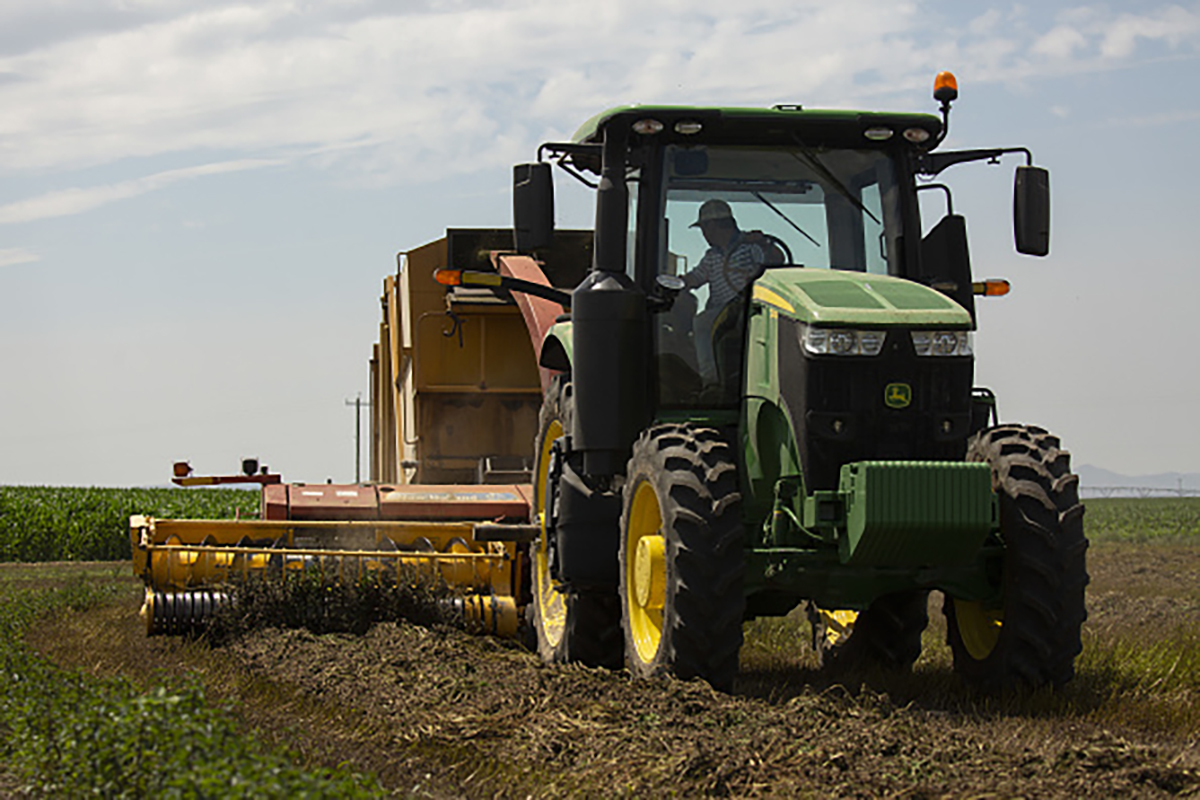
In terms of herbicide use, paraquat, glyphosate, and oxyfluorfen were the most frequently used for pre-plant burndown (Table 3). For pre-emergence weed control, the most common herbicides were terbacil, oxyfluorfen, and sulfentrazone. Post-emergence applications primarily included clopyralid, bentazon, and terbacil. When asked how often they apply herbicides during a growing season, most respondents (73%) reported applying herbicides two to three times while smaller proportions reported applying them once (9%), four to five times (9%), or more than five times (9%).
| Q16. What type of harvest practice do you use for your mint production? (n = 22) | Respondents, % |
Single-cut | 64 |
Double-cut | 36 |
| Q17. What methods do you currently use for weed management? Select all that apply. (n = 22) | Respondents, % |
| Chemical (herbicides) | 64 |
Mechanical (cultivation, tillage, hand weeding) | 14 |
Cultural (crop rotation, irrigation) | 18 |
| Physical (flaming) | 5 |
| Q18. How effective do you consider your current weed management practices? (n = 22) | Respondents, % |
Very effective | 23 |
Somewhat effective | 77 |
Not effective | 0 |
| Q19. Do you use pre-plant burndown herbicides? List the top three where Number 1 is the most frequently used herbicide. (n = 10) | |
Paraquat | |
Glyphosate | |
Oxyfluorfen | |
| Q20. Do you use pre-emergence herbicides? List the top three where Number 1 is the most frequently used herbicide. (n = 15) | |
Terbacil | |
Oxyfluorfen | |
Sulfentrazone | |
Clomazone | |
Flumioxazin | |
Pyroxasulfone | |
Pendimenthalin | |
Diuron | |
| Q21. Do you use post-emergence herbicides? List the top three, where Number 1 is the most frequently used herbicide. (n = 14) | |
Clopyralid | |
Bentazon | |
Terbacil | |
Clethodim | |
Bromoxynil | |
Flumioxazin | |
Oxyfluorfen | |
Paraquat | |
Pyridate | |
| Q22. How often do you apply herbicides in a growing season? (n = 22) | Respondents, % |
Once | 9 |
2–3 times | 73 |
4–5 times | 9 |
> 5 times | 9 |
Section 4: Weed management research and extension priorities
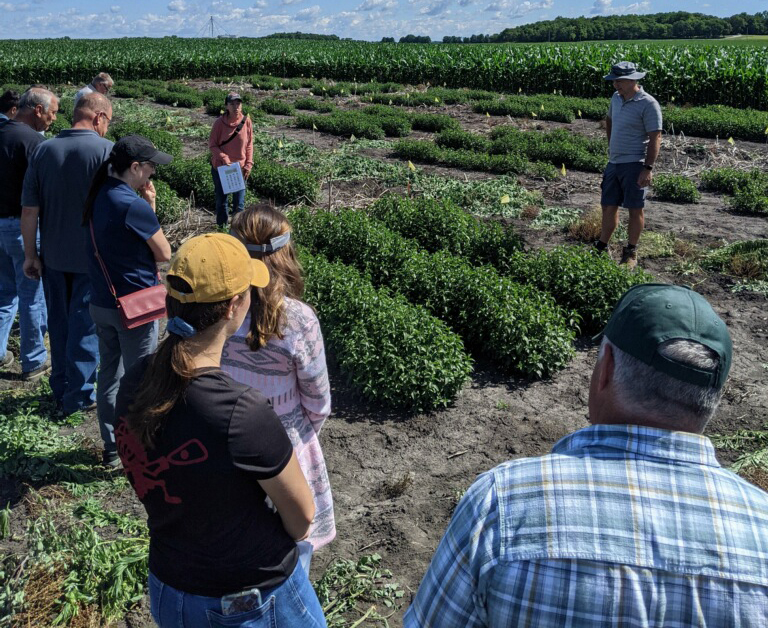
Survey participants identified key research and extension priorities for improving weed management in Oregon mint production (Table 4). The most frequently selected topics for additional information or training were herbicide efficacy and application timing, and herbicide resistance, each chosen by 68% of respondents. Weed biology and ecology were selected by 37% of respondents and non-chemical weed control methods by 26%. Regarding preferred formats for receiving weed management information, 90% of respondents favored field days, followed by workshops (70%), webinars and online courses (40%), and website posts (35%). An additional 10% selected “other” formats, including the Pacific Northwest Weed Management Handbook. Respondents also outlined future research and extension needs or expectations for the Extension Weed Specialist at Oregon State University. These included topics such as new herbicide chemistries and modes of action, optimal tank mixes and application timing, and the economics of herbicide resistance management practices, among others (Table 4).
| Q23. What topics would you like more information or training on? Select all that apply. (n = 19) | Respondents, % |
| Herbicide efficacy and application timing | 68 |
Herbicide resistance | 38 |
| Weed biology and ecology | 37 |
| Non-chemical weed control methods | 26 |
| Q24. How do you prefer to receive weed management information? Select all that apply. (n = 20) | Respondents, % |
Field days | 90 |
Website posts | 35 |
Workshops | 70 |
Webinars and online courses | 40 |
Other | 10 |
| Q25. What are your future research and extension needs or expectations for the Extension Weed Specialist at Oregon State University? List the top three. (n = 11) | |
New herbicide chemistries/modes of action | |
Alternative/diverse control methods | |
Resistance management | |
Optimal tank mixes | |
Optimal herbicide timing | |
Drone scouting | |
New weed species | |
Expanding weed range | |
Weed biology | |
Herbicide timing relative to weed biology | |
Economics of herbicide resistance management practices |
Implications for future research and outreach
The results of this survey provide valuable insights into the current weed management challenges faced by Oregon mint growers and will help guide future research and extension efforts. By aligning research priorities with growers’ needs, these findings can support the development of practical, science-based strategies tailored to the unique demands of mint production in the state.
References
ODA. (2024). Oregon agricultural statistics. Oregon Department of Agriculture. https://www.oregon.gov/oda/Documents/Publications/Administration/ORAgFactsFigures.pdf
Text © . The authors. CC BY-NC-ND 4.0. Except where otherwise noted, images are subject to copyright. Any reuse without express permission from the copyright owner is prohibited.




